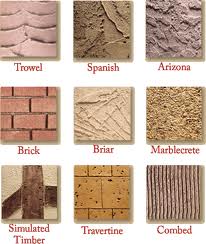Plaster solutions
Enhance has the Solution to Your Plaster Problems
Plaster, Exposed Aggregate: Stucco
Commonly referred to as stucco, it's a mixture of cement, sand and lime and normally used on exterior walls.
Leaking Stucco
The architectural appeal of stuccos is that it may be easily applied to curved or irregularly shaped surfaces. Details like coat thickness and proper application can have a major effect on its durability. Good stucco, applied well, still needs to have more attention than merely choosing the right color. When moisture penetrates the stucco membrane and comes in contact with structural members, a silent and invisible destructive process begins.
Perhaps you chose a synthetic stucco exterior because of its appearance. You might regret it, according to a recent NBC Dateline program called "Is your home crumbling around you?" Traditional stucco has a reputation for cracking. But that's nothing compared to the moisture problems with synthetic siding as revealed in the NBC story. The stucco referred to in this NBC program is a synthetic type with the trade name of "EIFS", or Exterior Insulating and Finish Systems. The complaints center on the materials apparent inability to drain moisture, a major deficiency in areas with lots of rainfall.
The National Association of Home Builders (NAHB), representing over 60,000 home builders nation wide, said synthetic stucco, "Isn't compatible with the existing wood frame construction methods in the United States." Even if meticulously applied and maintained, homes with synthetic stucco "develop moisture intrusion problems even when properly constructed according to industry standards," NAHB said.
Synthetic stucco also costs about 2-3 times as much as traditional stucco.  Both stucco systems can be protected from moisture with ESC repellents. Conventional stucco in addition can be rehydrated with EPC penetrants. When used in the conventional cement stucco mix, PMT will also produce a moisture resilient end product.
Both stucco systems can be protected from moisture with ESC repellents. Conventional stucco in addition can be rehydrated with EPC penetrants. When used in the conventional cement stucco mix, PMT will also produce a moisture resilient end product.
Cracking Stucco
Because stucco is a rigid material, a small number of hairline cracks are considered inevitable even on properly installed stucco; major cracking, however, is not typical. Excess cracking as a whole can be controlled through assisted hydration and prevention of rapid moisture loss. This is done integrally, within the mix, with the use of a PMT product. If cracks or resulting moisture ingress are a problem, surface applied architectural EPC and ESC treatments will help.
PMT-2-SM is primarily used in scratch and brown coat for waterproofing characteristics and structure protection.
Precaution: It is best not to use PMT in the color finish coat without the consent of the color coat manufacturer. This will avoid a rejected warranty claim in the event the cured color does not meet the performance warranties and representations or color is incorrect as supplied by the stucco cement and color manufacturer.
Estimated Cost of PMT Use in Stucco (expressed in Canadian $'s).
| PMT Consumption |
| Job Size (# of 40 Kg. Bags) | |||||
| Dosage | (L/Bag) | 18 | 27 | 36 | |
| Economy | 5 mL | 0.2 | 3.6 | 5.4 | 7.2 |
| Standard | 6.5 mL | 0.26 | 4.7 | 7.0 L. | 9.4 |
| Premium | 8 mL | 0.32 | 5.8 | 8.6 | 11.5 |
| Bold = Average Unit Value | |||||
| PMT Cost Based on Volume of Stucco per Unit |
| Job Size (# of 40 Kg. Bags) | |||||
| Dosage | Dose (L.) | 18 | 27 | 36 | |
| Economy | 5 mL | 0.2 | 43.88 | 65.83 | 87.77 |
| Standard | 6.5 mL | 0.26 | 57.05 | C$ 85.57 | 114.10 |
| Premium | 8 mL | 0.32 | 70.21 | 105.32 | 140.43 |
| Bold = Average Unit Value | |||||
Stucco mixing proportions may vary for different suppliers. Be sure to consult all manufacturer directions.
Mixing time depends upon the volume of material and fluidity of the mix. Insufficient mixing will reduce the quality of the stucco. Over loading the mixer will also reduce the stucco quality, regardless of mixing time.
Retempering: To minimize the need to retemper, stucco mortar should not be mixed more than 15 minutes prior to use. Retempering will not adversely affect stucco quality if only the evaporated water is replaced. Colored stucco should not be retempered.
Sand and Water: Always use good quality masonry sand. Course sand will produce a harsh stucco, while too much sand in the mix will generally increase shrinkage and decrease bonding. Always use good clean water.
Note: Stucco cements from some suppliers dry darker than desired. In this case it may be necessary to use White Portland Cement for lighter color finishes.
This Table is used by Lafarge to approximate mix design proportions.
| Mix Parts | Thickness (inches) | ||||
| Cement | Sand | 1/4 | 3/8 | 1/2 | 3/4 |
| 1 | 2.5 | 120 | 90 | 60 | 30 |
| 1 | 3.0 | 144 | 108 | 72 | 54 |
| 1 | 3.5 | 168 | 126 | 84 | 63 |
| 1 | 4.0 | 192 | 144 | 96 | 72 |
*Stucco Cement must conform to the requirements of CSA A8 and ASTM C91. The user is responsible for following recommended practices.
Plaster, Portland Cement: Pool Plaster
Finish for interior and exterior walls, it consists of Portland binder and aggregates.
Delamination and Cracking
In-ground shotcrete and plaster pools are very popular due to this moderate cost, fast, practical pool construction method. Waterscapes, color and design are infinitely flexible. The pool shell is generally stable for a relatively long life span. The water-tightness of the shell is of prime importance to the owner. The best way to achieve this over the long term is premium quality materials and mix. PMT admixtures assist hydration which in turn makes a water tight structure. The bond between shotcrete shell and plaster finished interior is also improved with the use of PMT because the shell will not extract moisture from the plaster, thereby creating a potential delamination failure. The same principle applies to the bond between the pool deck and the cool deck texture topping.
Pool Plaster also called Whitecoat or Marcite, provides the watertight seal that the more porous gunite or shotcrete beneath it cannot. Plaster finishes provide twenty years of service under ideal conditions, however, it is rarely an ideal world. The plaster surface is meant to degrade slowly, eventually requiring a fresh coat.
Enhance PMT-2-SM is designed for mortar and plaster mixes. As with other PMT products you will find significant improvements in the plastic qualities of the plaster mix and greater control of water content. PMT-2-SM assists the cement content to hydrate efficiently as well as maintain strong cohesive and bonding qualities.
Some problems reduced by use of PMT-2-SM:
- Mottled appearance common in finished pool plaster
- Staining due to minerals and metals in solution (see chart for causes of staining)
- Scaling and roughness from crystalline metallic salts deposits.
Stains in plaster occur for a number of reasons, most of them due to minerals or alkali metals. The following table will help you understand the source:
| METAL | SOURCES | COLORS |
| Calcium | Plaster, grout, mortar, cal-hypo chlorine shock | white crystals or precipitate |
| Copper | Copper algaecides, ionizers, corrosion of copper and brass pipes, fittings and heaters | blue, green & blue/green, black, dark red or teal |
| Iron | Well water, corrosion of iron pipe and fittings | dark red, brown, black, gray or green |
| Manganese | Well water | pink, red, black or red |
More Problems Solved
Stucco: Cohesiveness, Workability, Build-up, Coverage, Bonding, Moisture Retention (curing), Shrinkage, Efflorescence, and Permeability.
Pool Plaster: Cohesiveness, Workability, Bonding, Shrinkage
Promotions
 Would your company like to work with us? Contact Us to learn more about our joint venture program and cross-promotion opportunities.
Would your company like to work with us? Contact Us to learn more about our joint venture program and cross-promotion opportunities.







